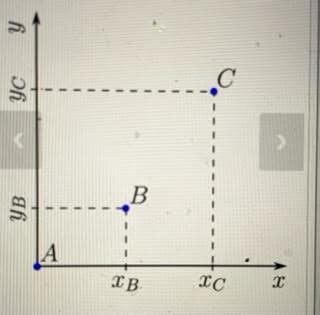The diagram represents the motion of an object in the xy plane with three points separated in time by equal time intervals, Δt with point A occurring first and point C occurring last. rA= (0,0) rB= (XB, YB) rC = (Xc, Yc) Numerically, the positioning of points Band C might differ somewhat from what is shown Part (a) What is the average velocity of the object between points A and B? Employing the unit vectors î and ĵ, enter your response in Cartesian unit-vector notation. Note that the average velocity best represents the velocity at the average time for the given interval, as indicated by the second image in the problem statement. Part (b) What is the average velocity of the object between points B and C? Employing the unit vectors î and ĵ, enter your response in Cartesian unit-vector notation. Note that the average velocity best represents the velocity at the average time for the given interval, as indicated by the second image in the problem statement. Part (c) Building on your results for Part (a) and Part (b), what is the average acceleration for interval shown? Employing the unit vectors î and ĵ, enter your response in Cartesian unit-vector notation. Note that the average acceleration best represents the acceleration at the average time between VAB and VBC Given (xB,yB)=(3.06m,2.52m) (xC,yC)=(5.78m,7.69m) and Δt=2.91s what is the x component, in meters per squared second, of the average acceleration? Part (e) Using the data values from Part (d), what is the yy component, in meters per squared second, of the average acceleration? Part (f) Into which quadrant does the average acceleration point? Please can you help me with this entire problem I already work on it but it still says its wrong, thank you
The diagram represents the motion of an object in the xy plane with three points separated in time by equal time intervals, Δt with point A occurring first and point C occurring last.
rA= (0,0)
rB= (XB, YB)
rC = (Xc, Yc)
Numerically, the positioning of points Band C might differ somewhat from what is shown
Part (a) What is the average velocity of the object between points A and B? Employing the unit vectors î and ĵ, enter your response in Cartesian unit-vector notation. Note that the average velocity best represents the velocity at the average time for the given interval, as indicated by the second image in the problem statement.
Part (b) What is the average velocity of the object between points B and C? Employing the unit vectors î and ĵ, enter your response in Cartesian unit-vector notation. Note that the average velocity best represents the velocity at the average time for the given interval, as indicated by the second image in the problem statement.
Part (c) Building on your results for Part (a) and Part (b), what is the average acceleration for interval shown? Employing the unit vectors î and ĵ, enter your response in Cartesian unit-vector notation. Note that the average acceleration best represents the acceleration at the average time between VAB and VBC Given
(xB,yB)=(3.06m,2.52m)
(xC,yC)=(5.78m,7.69m)
and Δt=2.91s what is the x component, in meters per squared second, of the average acceleration?
Part (e) Using the data values from Part (d), what is the yy component, in meters per squared second, of the average acceleration?
Part (f) Into which quadrant does the average acceleration point?
Please can you help me with this entire problem I already work on it but it still says its wrong, thank you

Trending now
This is a popular solution!
Step by step
Solved in 3 steps with 3 images




